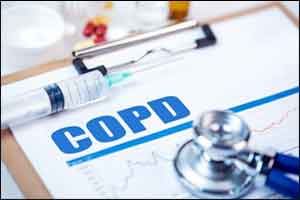- Home
- Editorial
- News
- Practice Guidelines
- Anesthesiology Guidelines
- Cancer Guidelines
- Cardiac Sciences Guidelines
- Critical Care Guidelines
- Dentistry Guidelines
- Dermatology Guidelines
- Diabetes and Endo Guidelines
- Diagnostics Guidelines
- ENT Guidelines
- Featured Practice Guidelines
- Gastroenterology Guidelines
- Geriatrics Guidelines
- Medicine Guidelines
- Nephrology Guidelines
- Neurosciences Guidelines
- Obs and Gynae Guidelines
- Ophthalmology Guidelines
- Orthopaedics Guidelines
- Paediatrics Guidelines
- Psychiatry Guidelines
- Pulmonology Guidelines
- Radiology Guidelines
- Surgery Guidelines
- Urology Guidelines
Journal CHEST publishes tips to reduce Heart Failure and COPD readmissions

Chronic obstructive pulmonary disease (COPD) and heart failure (HF) diseases arise from similar root causes, have overlapping symptoms, and share similar clinical courses. Such patients also have a high cost of care.
As both COPD and HF have strong parallels, strategies to reduce readmissions in patients with both conditions share synergies. Comorbid heart failure and COPD are costly to treat, but reducing readmissions can lower the total cost of care.
The 10 practical tips to reduce readmissions for patients with both HF and COPD was published in the journal Chest.
1. Make Accurate Diagnoses
Several tests, including echocardiography, can diagnosis HF in COPD patients.
Read Also: Smoking increases the risk of heart failure : Study
According to the authors, as spirometry is not thought to be accurate during acute HF exacerbation, anatomic assessment of lung parenchyma with CT scan may offer valuable adjunctive information at the reasonably high sensitivity and specificity. In addition, the chest CT scan may offer valuable ancillary information regarding right heart size, the diameter of the pulmonary artery, and the presence of coronary calcification.
2. Strive For Early Detection Of Exacerbations
Early detection of patients with both COPD and HF to reduce readmissions is beneficial for two reasons.
First, specialists can be involved quicker, which allows for faster determinations about root causes of patients' COPD or HF. Specialist involvement also quickens the development of treatment plans.
Second, early identification during hospitalization allows time to deploy multidisciplinary interventions, such as disease management education, social work evaluation, follow up appointment scheduling, and coordination of home services.
3. Ensure Specialist Management In The Hospital
Specialists not only maximize the quality of inpatient care but also can play a key role at the time of discharge.
4. Address Root Causes
The researchers addressed that HF has several correctable root causes. Identification of and treatment of occult ischemic heart disease, valvular heart disease, systemic hypertension, and pulmonary hypertension all have potential to make the HF syndrome more tractable.
5. Use Evidence-Based Therapies
"For HF, several kinds of medications have shown effects such as beta-blockers, angiotensin receptor blockers, and aldosterone antagonists. "Not only are there long-term outcome benefits for these therapies, but evidence also suggests early initiation of HF therapies can reduce 30-day readmissions," the researchers wrote.
Read Also: Triple therapy lowers exacerbation rate in COPD : BMJ
There are fewer evidence-based therapies linked to reduced readmissions for COPD, but earlier research has shown that noninvasive positive pressure ventilation reduces readmission at 28 days compared with oxygen alone.
6. Engage Patients In Their Care
Enlisting HF and COPD patients as active participants in care and monitoring exacerbations is essential.
7. Establish Feedback Loops
Feedback loops can allow for clinical stabilization before rehospitalization is necessary. Self-care plans for both COPD and HF have been found to be effective. Nurse-led telephone follow-up for COPD and HF at 48 to 72 hours may also help support patients post-discharge.
8. Schedule Follow-Up Appointments
Before hospital discharge, a follow-up appointment should be established with an advanced practice provider or nurse with pharmacist support.
"The purpose of early follow-up is (1) to identify and address gaps in the discharge plan of care, (2) to retailer the discharge plan of care to better suit the patient in the outpatient environment, (3) to reinforce critical health behaviors, and (4) to advance the plan of care, time permitting," the researchers wrote.
9. Address Other Comorbidities
Multiple comorbidities such as septicemia and renal dysfunction are common for patients with COPD and HF, the researchers wrote.
"This underscores the need for involvement of the primary care physician for assistance in managing comorbidities. In a study evaluating the process of care metrics associated with better outcomes in patients hospitalized with HF," wrote the authors.
Partnering with community physicians and arranging to send discharge summaries to the primary physician were among the strategies most associated with lower readmission risk.
10. Arrange Home Health Services
For HF patients, home services such as physical therapy, patient education, and medication instruction have been associated with reduced readmission rates at three to six months. Telehealth has shown effectiveness in managing COPD.
For reference log on to https://doi.org/10.1016/j.chest.2018.06.001

Disclaimer: This site is primarily intended for healthcare professionals. Any content/information on this website does not replace the advice of medical and/or health professionals and should not be construed as medical/diagnostic advice/endorsement or prescription. Use of this site is subject to our terms of use, privacy policy, advertisement policy. © 2020 Minerva Medical Treatment Pvt Ltd